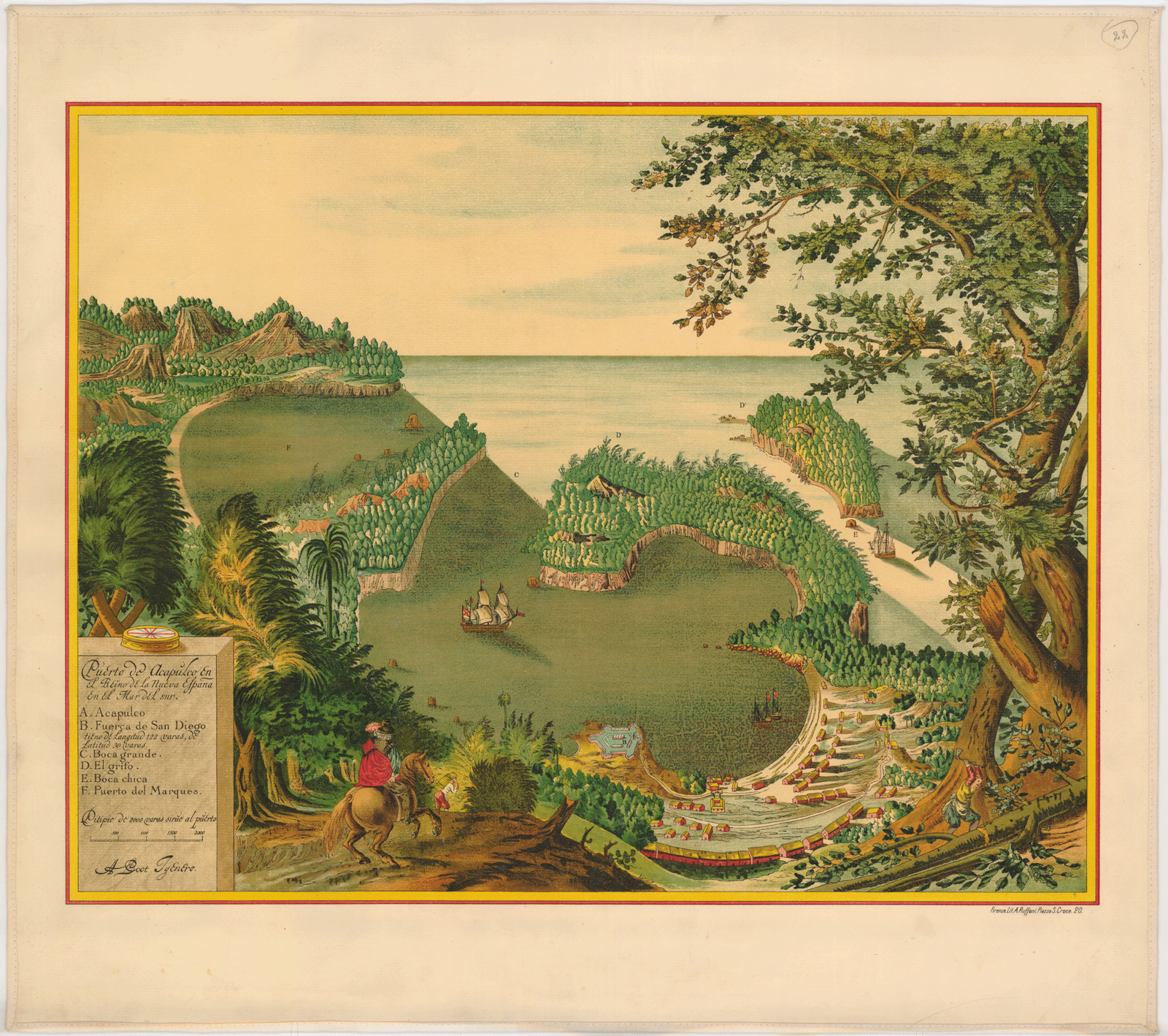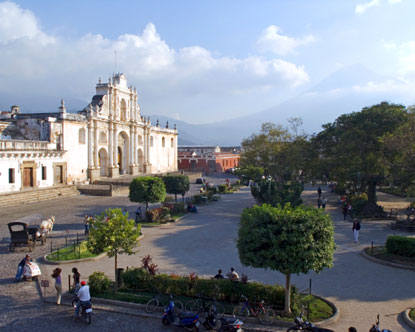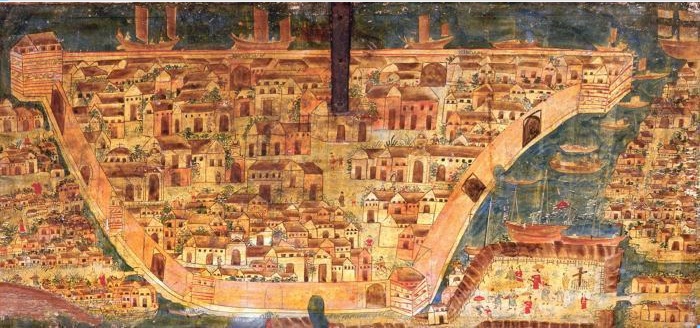At the height of the Spanish Empire, the Manilla Galleon – an annual flotilla between Manilla and Acapulco – was considered the lifeline of Spain’s economy, bringing silver from the mines of New Spain to the markets of Asia. On the reverse trip, the galleons would be loaded with Asian luxury goods, such as spices, silks — and slaves. This episode presents a micro history of the Trans-Pacific slave trade through the lens of Diego de la Cruz, a chino slave who managed to escape and evade capture for three years in the highlands of Central America. Guest Kristie Flannery found Diego’s story in the Spanish colonial archives, and narrates his tale in the broader context of the powerful political and economic forces at work in Spain’s global empire.
Guests
 Kristie Patricia FlanneryPostdoctoral Fellow, University of British Columbia
Kristie Patricia FlanneryPostdoctoral Fellow, University of British Columbia
Hosts
 Christopher RosePostdoctoral Fellow, Institute for Historical Studies, The University of Texas at Austin
Christopher RosePostdoctoral Fellow, Institute for Historical Studies, The University of Texas at Austin
Today we’re going to talk about Asian slavery in colonial Latin America, specifically looking at one slave in particular, Diego De la Cruz, as a sort of archetype for the institution as a phenomenon. So why don’t we start off by talking a little bit about the emergence of Spain’s Asian empire.
Sure. I think you know today that manila is the capital of the Philippines, which is a Southeast Asian country. Actually, the 12th largest country in the world, even though I don’t think it gets talked about very much. But, for more than 300 years from the late 1500s to the late 1900s, Manila is the capital of the Spanish empire in the Asian-Pacific world. I think most people associate the Spanish empire with Latin America, but at its height Spanish Empire included a lot of Latin America, as well as colonies in Asia: the Philippines, the Marianas and the Carolinas islands.
So, how did the new Spanish Empire extende to Asia in the first place? We know that Columbus landed in the Americas, which is a long way from Manila.
I think, what maybe people forget, is that when people’s Columbus set out for the Americas in 1492 his goal wasn’t to get the Americas his goal was to get to the Indies. The end is, refers to China, Japan, and India at that time to Europeans. Columbus knew that the Indians were really rich – there was gold and silver, he believed; spices such as cloves and cinnamon, jewels and pearls so really is intention was to go to to Asia. After Columbus discovered America, that dream of colonizing Asia was never really abandoned by the Spanish. So by 1564, you see the Spanish finally realizing that dream of establishing a colony in the Philippines. First they arrive in Cebu, and then they establish their capital in Manila.
What was the motivation for establishing a new capital at Manila?
Well, probably there were three reasons why the Spanish chose Manila. The first is that the location was ideally suited for trade with China. In fact, when the Spanish arrived there were already Chinese merchants visiting and trading with the locals. So, it was very easy for the Spanish to join the trade that already existed. We shouldn’t forget that the Philippines was also a source of wealth for the Spanish. They would taxed natives in the form of tribute, and so in that way the Spanish became rich from the Philippines itself. And third, Manila was an ideal location for the Spanish objective of converting all of Asia to Christianity. So a lot of different missionary organizations were set up there.
Even today, Manila is a long way away, but in the 16th century it was an incredible distance. How was it connected to the rest of the Empire? How was it managed?
Some historians have described the Manilla Galleon as the umbilical cord that connected Manila in the Philippines to Mexico in the Americas. The galleons are these huge ships that sailed between Acapulco and Manila almost every year, for roughly 250 years, until 1815. The galleons brought silver from Mexico to the Philippines and they returned from the Philippines with all these exotic luxury goods from China and other parts of Asia. And, as you said the voyage was really long. It’s hard to imagine that the trip from Acapulco to Manila was almost two or three months in duration, and the return trip could take six months.
We mentioned that some of the goods going back and forth between Asia and America were things like spices, silks, porcelain. Since we’re talking about the slave trade out of Asia, are we also to assume that there were slaves coming on these galleon ships as well?
Yes, they were definitely slaves coming on the galleon ships. But, I think we tend to focus on the porcelain, jewels, and spices and forget that slaves also made that journey. Manila was a slave holding society. Slavery was very common in Manila, as it was in many other cities in Spain’s global empire. A contemporary observer guessed that one-third of the population of Manila in the early 1600s were slaves. So, slavery was very common in Manila.
I think an interesting thing about slavery in the Philippines that maybe was different from slavery in other parts of the Americas was that Manila’s slave population was ethnically diverse. We do see Africans enslaved in the Philippines, coming from the Indian Ocean slave trade through the Portuguese colonies in East Africa. But we also see people from India enslaved in Manila. They’re often described as Bengalis. And also, the Spaniards themselves, for a lot of the time that Manila was a colony the Spaniards were fighting wars with Muslim states in the southern Philippines and in Malaysia. When the Spanish would defeat these enemies in war they would often enslave these people. So we do see Filipino Muslim slaves in the Philippines.
So, what do we know about the slaves? What were they doing? What happened when they got to the Americas?
Well that’s a great question. Unfortunately we don’t have a lot of information about most of these individuals but sometimes they turn up in the colonial archive in surprising and unexpected ways.

That brings us to Diego de la Cruz. So, how did you find him? What do we know about him?
Thanks to the wonders of the Internet—A lot of archives these days have been partially digitized, or indexes to the archives have been put on the Internet. I was able to spend some time searching keywords like chino in the Spanish government archive website and that led me to find a few records, including one about this Asian slave whose name was Diego de la Cruz. Diego was brought to Guatemala actually, on a galleon shipped in the mid 1600s. He runs away in Guatemala and two years later he’s arrested for theft and put on trial. So what we have is that trial record. And that trial record tells us about Diego’s experiences as a Chino slave in America, and more importantly his attempts to become free.
Can you expand on what the term chino means in the context of the Asian slave trade?
Sure. Chino was a fluid ethnic category. Although in Manila a lot of these slaves from different parts of the Indian Ocean and Asian the Pacific world would’ve been described as Jolano or Bengali, once they arrived in the Americas they were all described as chinos. So I guess this term could really preferred to anyone, any slave from this part of the world.
So it just sort of signified that they came in from Manila on the big galleon?
Yes, it’s sort of a generic term for Asians.
So, what were you able to find out about Diego de la Cruz from the historical records?
One of the most interesting things about this trial record that we have is that Diego tells us some things about his biography in his own voice. So Diego told the judge, and all of us now who are reading this trial, that he was born a slave, in Manila, In his master’s house around 1630. So his powers could’ve been from Bengal or Mindanao, we’ll never know for sure.
In 1657, when Diego was about 30 years old, he accompanied his master on a voyage from Manila to the Americas onboard a Galleon ship. This voyage ended in disaster for both men. The ship, which was called La Nuestra Señora de la Victoria, suffered a slow and arduous Pacific crossing. Diego’s master died on the voyage. Perhaps he was sick, he wasn’t eating a very healthy diet. This ship was also way off course and finally weighed anchor at a port called Ampala, which today is known as La Unión in El Salvador — which is way out of the way from Acapulco.
From what you were describing, Diego wasn’t necessarily sent across as a slave, but he was accompanying his master as a personal servant I would assume?
Yes, it was common for people who were more elites to travel with their slaves. So priests would commonly with travel with slaves, as would ship captains and other wealthy important passengers.
So what happens when they get to El Salvador?
When they first arrived in the port, the legal process was that a local legal official confiscated the goods of anyone who died during the voyage. The idea was that they were going to sell that property, and whatever money was made would be sent back to their inheritors who were probably in Spain. So, if they had children or widows they would somehow get the money through this huge transcontinental bureaucracy that was the Spanish Empire.
Diego De la Cruz, he’s taken by the government officials, and locked up in a prison with the intention to sell him later and send the profits to his master’s family. Diego finds himself in the city of San Miguel, which is close to the port, locked up in a prison cell, waiting to be sold to a stranger, in a strange place thousands of miles from home.
What’s interesting is that when he’s in a prison, Diego began to show signs of sickness. Now, this might be real signs of sickness, or maybe he was pretending. Seeing that he was sick, the prison guard took Diego into his own home to recuperate and from here, Diego escaped. He ran away into country he didn’t know, and basically refused to except the life that colonial law said that he should live.
That must’ve been very difficult for him. This is colonial Latin America, and Spanish would not have been as common in the area does that he would have been fleeing to as a spoken language. He clearly looked different. So, how did that go for him?
Well, I think we can empathize with the situation of being a foreigner, in a strange place, and especially the misfortune of landing in El Salvador instead of Acapulco probably meant that there weren’t many other chinos in the port. I think we can assume that Diego spoke Spanish, and that there were people in this region north of city who spoke Spanish. And that would’ve helped. Running away—historians use the word maroonage or marronage to describe this act of running away—and one historian Marcus Rediker says that the act of running away requires many kinds of knowledge to be successful. Technical knowledge, natural and social knowledge. And of these social knowledge, or “how do I cooperate to make alliances?” is really key. So that’s why this act of running away was particularly challenging for Diego de la Cruz. Because he’s in this unfamiliar place, so far from home, and it would’ve been much more difficult to navigate the sort of social relationships operating in Guatemala at the time.
So, what did you do after he ran away?
Well, the trial record that we have, which is the only document that tells us about Diego’s life, says that after Diego ran away he was missing for two years. And after two years he’s arrested for theft. And the judges really surprised at Diego’s ability to remain on the run for so long. And the judge said, “This is a miserable poor man who does not know anyone in the city or how he could work to support himself.” So, the judge is surprised to that Diego ran away, and asked him to explain how he could survive out there.
Diego tells us that, after escaping from prison, he remained hidden at a hacienda, which is kind of like a farm, belonging to the sargento mayor. We don’t really know if Diego chose to work there of his own volition, or if he was working there, held without his consent or against his will. And he says that after two months on this farm, he went on a trip with the mulatto mule driver to a close by city and on the way back he escaped.
So it could’ve been a mutually beneficial working relationship, but we don’t know anything about his connection to either these estate owner or the mulatto—what did you call him? A muleteer? What’s a muleteer?
A muleteer is someone who is responsible for driving donkey train through the mountains carrying goods to market. We don’t know what his relationship with this muleteer was; maybe they were friends, and his friend helped him escape to the next city where he might be able to live better as a free man. Maybe he was able to pay him. I think that we can guess that his ability to speak Spanish help him to negotiate this arrangement.
What happens next after he escapes from this estate?
Diego testified that he then made his way to the capital, Santiago de Guatemala, which is a 250 mile journey. He says he traveled alone, and the circumstances of his arrest suggest that he was surviving as a nomad, living as a vagabond, stealing to get by, and there’s no evidence that he really joined any community.
Stealing to get by, and he manages to make what is a pretty arduous trip through the mountains even today up to what is now Guatemala City.
Actually it would’ve been Antigua—
—oh right, yes!—
The original city was destroyed in an earthquake and shifted pretty close by. It’s a long way, and it would’ve been difficult to navigate. Unfortunately for Diego, his luck turned against him one night in July 1659. In a town called San Bartolomeo, an indigenous woman whose name was Maria Settina woke up one night and heard noises coming from the patio outside her house. She went to investigate these unexpected footsteps and discovered that she had been robbed. She was missing clothes, her daughter’s clothes were gone. Several expensive embroidered blouses, petticoats, and a valuable decorative hair comb were missing. Maria was very upset about being robbed, and she immediately went out to get help from her 25-year-old nephew Bartolomeo, who happened to be the judge of the nearby town of Espiritú Santo.
Bartolomeo went to wake up his friends Domingo Hernandez and Antonio Marquez who were the town’s regidores or government officials. And they set out to see if they could find the criminal who had robbed Bartolomeo’s aunt. And in the musky light of dawn they found a mulatto—as they described him—sleeping alone, under a pile of clothes, which they were pretty sure belonged to Maria Sakina. And that man sleeping under the pile of clothes was Diego De la Cruz.
So, his luck it finally ran out.
That’s right.
Well, we know he went to trial. So, they arrested him on the spot, presumably?
The men woke Diego up. He tried to bargain with them, he handed over the clothes so they would let him go free, but they were intent on having Diego punished under the law. Those men took Diego to a local judge, Miguel Geronimo, and the judge then began an investigation into the theft. I think what’s very interesting—and you can read the transcript of that investigation—is that many people come out to testify against Diego. So Maria Settina, all those men involved in the search, but not one person tried to protect or defend Diego De la Cruz.

So what was the outcome of the trial?
Well, during the trial, Diego tried to get off the charge. At one point he said he was sleeping under the clothes, but he didn’t know how they ended up there. The judge didn’t buy it. Later he did admit to stealing the clothes. The trial also establish that Diego De la Cruz was a runaway slave. They were able to connect his identity with the reports of the man who had gone missing from the port two years earlier. So the judge ruled that—in addition to being punished for the theft which involve being would tied to a pole and whipped in the Plaza Mayor of Guatemala City in front of muchas personas—Diego was also sold into slavery for 220 pesos. This was the end of the original intention of the government.
Since you mentioned that this is the only documents in which Diego appears, I presume that from here he vanishes into the historical record.
He does. I think that it would be amazing to spend some time sifting through the records and trying to find out what happened to his Diego after this point. Does he manage to escape again? Does he manage to get back to the Philippines can be reunited with his family? We really don’t know what happened from this point.
It’s the historian in me, I want to know! Unfortunately, especially when we’re dealing with the archives for the premodern era, you just have to follow the lead and sometimes the trail goes cold.
That’s true. I think we’re really lucky to have this one’s source because without it we wouldn’t know anything about him. We wouldn’t even know that this man existed.
Moving toward wrapping up, how much longer did the Asian slave trade remains an important part of the transpacific Spanish empires trade?
Well that’s a good question. Really Asian slavery is something that historians have only very recently began to examine in a serious way. One historian, her his name is Tatiana Seijas, has done a lot of important work on this issue. This new research is showing that, in the early 1600s, Asian slavery was legal, in that the government allowed merchants to buy licenses to import these slaves, and require them to register slaves that they would import through Acapulco. Although there were certainly a lot of smuggling of slaves at that time. But, by the late 1600s, the transpacific slave trade is pretty much eradicated.
What led to its eradication?
In the 1670s the Spanish crown declared that índios—indigenous peoples—could no longer be enslaved. After that, the only legal slaves in New Spain were those with African ancestry. This came about in large part because the church was saying, rightfully so, that indigenous slavery impeded Christianization. And also people who were invested in bringing African slaves to the Americas didn’t appreciate the competition.
You also see a lot of pressure from indigenous people themselves, making the case against enslavement of indigenous people. And what chinos were able to do in New Spain was establish that they were also índios, they were índos chinos. You see people from the Philippines and other parts of Asia who are enslaved in Mexico joining indigenous parishes and marrying indigenous women, because many of slaves were men. And this is one way for them to establish an identity as Indian. They also challenged there’s enslavement in the court. In Mexico there was a court called the General Indian Court, and it’s where Indian people would go and complain about various abuses of their rights. So we do see chinos turning up at this court and saying, “I’m índio chino and I can’t be enslaved because of this law.” So it’s really interesting that over that century, we see the emergence of racial slavery.
